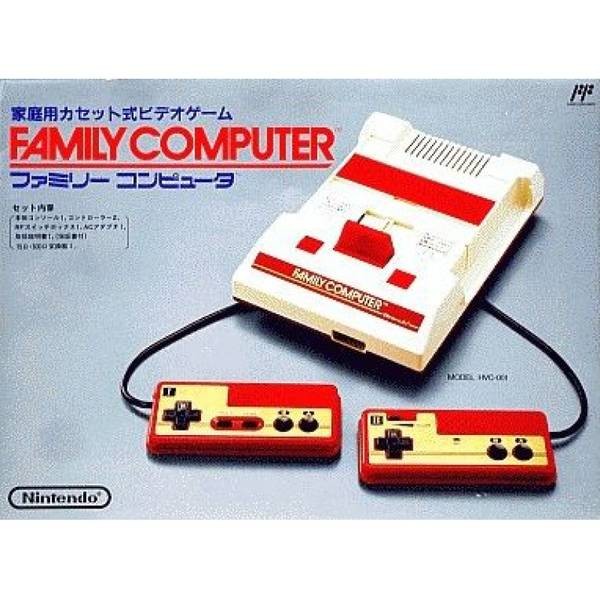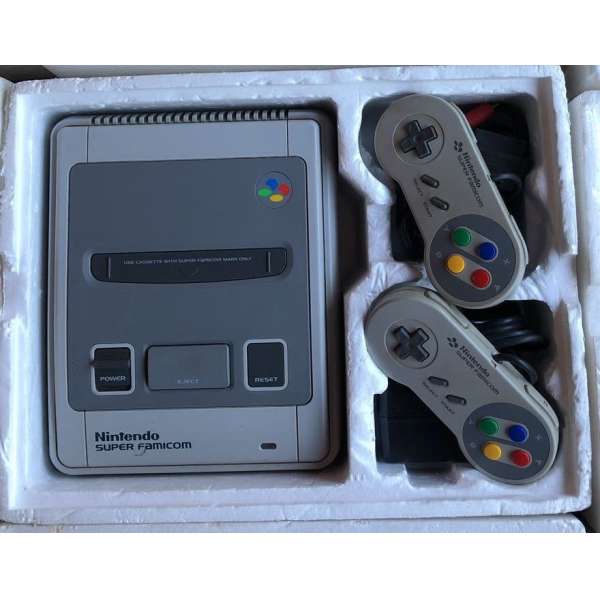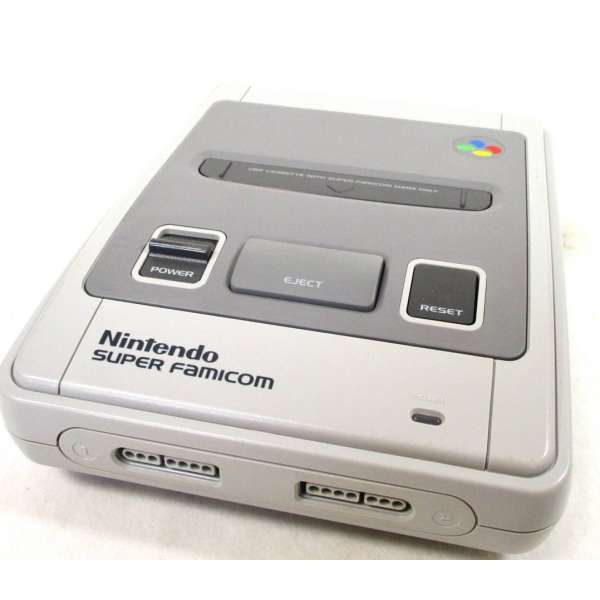任天堂主機/紅白機
任天堂成立1889年9月23日,早期製造日本花札的紙牌,後來轉型製作掌上型主機Game&Watch,並於1983年7月推出家用遊戲主機,當時最早結盟的軟體開發廠商有6家,分別為NAMCO、HUDSON、TAITO、CAPCOM、JALECO及KONAMI。任天堂紅白機於2003年7月正式停產,走入歷史。而後期日本則有推出紅白機+超任遊戲的COMBO機、早期SHARP也有推出紅白機及磁碟機2合一的主機及主機+電視的稀有商品。而今亞洲國家仍製造與任天堂紅白機同規格的主機,通常在大賣場較容易看見,每台均價約700元區間,但因插卡設計不佳,容易損害卡帶,並不建議購買。
早期遊戲由唯讀記憶體ROM卡帶的形式推出,依照不同容量分別有24K、40K、48K、64K、80K、128K、160K及256K等。一般日系遊戲廠商不會推出合卡,除了少數超任推出的瑪莉兄弟合輯或忍者龍劍傳~巴外,若有推出合卡應該都是台製的。通常書盒完整的紅白機商品會附有說明書、兩隻十字鍵控制器(II會有調整的麥克風)、RF轉換器、AV端子及電源供應器。RF轉換器用在早期的冷陰極管電視,若用在LCD或是LED電視,有時後會造成螢幕畫面狀況不佳。主機下方有擴展的的連接口,可用來接其它配件如光線槍、連發控制器等(早期台製的主機,手把本身就附有連發功能)。1983年初代出的主機控制器按鈕是方塊型,因不符人體工學,因此改成圓型,但卻意外造成收藏家用來分辨初代的方式,一台初代主機市價約在12,000~15,000元區間。
紅白機(Red and White Machine),或稱「Famicom」(Family Computer)是任天堂於1983年推出的8位元家用遊戲主機,而在海外則稱為「Nintendo Entertainment System」(NES)。以下是紅白機(NES / Famicom)的歷史概述:
推出背景:紅白機於1983年在日本首次發布,成為家用遊戲主機的先驅之一。當時的遊戲市場受到影像遊戲危機的影響,遊戲業界的盈利下滑。紅白機的成功幫助重新激發了遊戲市場的興趣,並為日後的家用遊戲主機定下了基調。
硬體特點:紅白機採用8位元的中央處理器(CPU),並具有64KB的記憶體。它使用卡匣(遊戲卡帶)作為遊戲載體,這讓遊戲開發商能夠在不同的卡匣中創建各種遊戲。紅白機的控制器設計採用了方向鍵、A和B按鈕,以及Start和Select按鈕,這個經典的控制器配置對後來的遊戲主機產生了深遠的影響。
遊戲庫:紅白機的遊戲庫包含了許多經典的遊戲,如《超級瑪利歐兄弟》、《塞爾達傳說》、《俄羅斯方塊》等。這些遊戲不僅在當時獲得了極高的評價,也成為了遊戲史上的經典之作。
全球擴展:紅白機在全球范圍內獲得了巨大的成功,幫助任天堂建立了在家用遊戲市場的地位。在北美地區,紅白機被重新命名為「Nintendo Entertainment System」,並於1985年推出。它的成功也促使其他公司開始進入家用遊戲主機市場。
影響:紅白機的成功影響了整個遊戲行業。它不僅確立了任天堂作為主要遊戲公司的地位,也對遊戲設計、控制器配置和商業模式等方面產生了深遠的影響。紅白機的遊戲和概念在許多後來的任天堂主機中得以延續和發展。
創新遊戲概念:NES / Famicom帶來了許多創新的遊戲概念和玩法。例如,遊戲開發商創造了第一個橫向捲軸平台遊戲《超級瑪利歐兄弟》,這成為了日後遊戲中常見的模式。此外,這個主機也為冒險遊戲的興起鋪平了道路,如《塞爾達傳說》系列。
遊戲產業復興:NES / Famicom的成功重塑了遊戲產業,促使許多公司開始投入遊戲開發和主機製造。這也引領了遊戲市場的蓬勃發展,從此遊戲不再只是玩具,而成為文化的一部分。
商業模式創新:NES / Famicom推出了「任天堂專有」(Nintendo Seal of Quality)的封印,這表明遊戲經過了品質審查。這種制度有助於確保遊戲的品質,並為玩家提供優質的遊戲體驗。同時,NES / Famicom也是首次引入租賃和授權模式的主機,讓第三方遊戲開發商可以創建遊戲。
文化影響:NES / Famicom不僅在遊戲界產生了影響,還對流行文化產生了重要影響。許多紅白機的遊戲角色和音樂成為了文化的一部分,如《超級瑪利歐兄弟》的瑪利歐和《塞爾達傳說》的主題曲。
後續機種:NES / Famicom的成功啟發了許多後續的遊戲主機,如超級任天堂(Super Nintendo Entertainment System)、任天堂64(Nintendo 64)等。這些主機延續了NES / Famicom的遊戲精神,同時也在技術和遊戲設計方面進行了創新。
限制與創意: 由於當時的技術限制,NES / Famicom的遊戲開發受到了空間和硬體限制。這迫使遊戲開發商在有限的資源下發揮創意,創造出了許多引人入勝的遊戲。這種限制催生了許多經典的遊戲設計和機制。
遊戲適應不同市場: 在不同地區,部分遊戲可能因為文化差異而進行了修改。例如,某些遊戲的角色外觀和遊戲內容可能會因為地區的文化背景而有所調整。這使得遊戲能更好地適應各個市場。
延續影響: NES / Famicom所確立的許多遊戲設計原則和概念在今天仍然存在。例如,橫向捲軸平台遊戲、冒險遊戲、角色扮演遊戲等類型在現代遊戲中依然廣泛存在,並受到玩家喜愛。
經典遊戲庫: NES / Famicom的遊戲庫包含了許多被譽為經典的遊戲,這些遊戲在遊戲史上擁有特殊地位。這些遊戲不僅在當時取得了成功,也為日後的遊戲開發和設計設下了基準。
懷舊價值: NES / Famicom仍然擁有強烈的懷舊價值,許多玩家至今仍然保留著這個主機以及其中的遊戲。經典的遊戲和控制器設計引起了很多人的回憶和情感。
機種變化和進化: 隨著時間的推移,NES / Famicom也經歷了一些變化和進化。例如,在日本,原始的紅白機在後來推出了更小型、外形更簡約的「AV Famicom」版本。在北美,NES也經歷了一些外觀和硬體上的變化。
Modding 和Homebrew: 因為NES / Famicom的經典地位,許多愛好者和開發者開始進行自定義的Modding(改裝)和Homebrew(自家製作)項目。這些項目可以包括修改現有遊戲、創建新的遊戲、改裝主機外觀等。
復刻版主機: 近年來,任天堂推出了一些復刻版的NES / Famicom主機,如「Nintendo Classic Mini: Nintendo Entertainment System」和「Nintendo Classic Mini: Family Computer」。這些主機重新設計並內置了多個經典遊戲,讓玩家可以重溫過去的遊戲體驗。
響其他媒體: NES / Famicom的成功不僅影響了遊戲產業,還影響了其他媒體形式。許多NES的遊戲被改編成電影、電視節目、漫畫等形式,這進一步推動了遊戲文化的擴展。
經典音樂: NES / Famicom的遊戲配樂也是受到廣泛讚譽的。許多遊戲的音樂成為了經典,並持續在玩家心中保持著特殊的地位。這些音樂在現代的音樂演奏仍然廣受歡迎。
有關任天堂紅白機(Famicom)和NES(Nintendo Entertainment System)的技術細節:
1.中央處理器(CPU):紅白機和NES都使用了一個8位元的中央處理器。在Famicom中,CPU型號是Ricoh 2A03,運行速度約為1.79 MHz(NTSC版本)或1.66 MHz(PAL版本)。
2.圖像處理單元(PPU):Famicom和NES使用圖像處理單元來處理圖像和顯示。PPU負責生成遊戲的圖像和背景,並具有將多個圖層合併成單一畫面的能力。
3.顏色和圖形限制:由於硬件限制,Famicom和NES在顏色數量和圖形解析度方面受到了限制。這導致遊戲開發者必須巧妙地運用顏色和圖形設計,以創造視覺上令人印象深刻的遊戲。
4.音頻硬件:Famicom和NES的音頻系統包括數個聲音通道,如方波聲音、三角波聲音和噪聲通道。通過這些通道,遊戲開發者可以創建豐富的音樂和音效。
5.遊戲卡匣(遊戲卡帶):Famicom和NES的遊戲以卡匣的形式發布,這些卡匣包含了遊戲的程式和數據。這種卡匣系統使得遊戲能夠更大、更複雜,並且有助於將遊戲容易地插入主機中。
6.控制器和按鈕配置:紅白機和NES的控制器設計都包括了方向鍵、A和B按鈕,以及Start和Select按鈕。這種經典的按鈕配置影響了後來的遊戲控制器設計。
7.儲存限制和程式設計創意:Famicom和NES的遊戲卡匣儲存容量有限,這迫使遊戲開發者要在有限的空間內創造出豐富的遊戲內容。這也促使他們采用創新的程式設計技巧,以實現視覺效果和遊戲機制。
8.租賃系統和封印保證:任天堂引入了租賃和封印保證系統,確保了遊戲品質的一致性。只有通過任天堂審核的遊戲才能獲得「任天堂專有」(Nintendo Seal of Quality)的封印。
9. 遊戲設計原則和創新:Famicom和NES的硬件限制迫使遊戲開發者發揮創意,創造出許多令人驚嘆的遊戲。這也促使他們發展了許多遊戲設計原則,這些原則至今仍然影響著遊戲設計師。
10.滾動技術: 紅白機和NES上的許多遊戲使用了滾動技術,使畫面能夠平滑地移動。由於硬體的限制,畫面無法同時呈現大量的圖像,因此滾動技術使遊戲能夠展示更大的遊戲世界。
11.編程技巧: 遊戲開發者必須使用各種編程技巧來實現他們的遊戲目標。例如,為了在有限的記憶體中實現複雜的遊戲,開發者可能會使用壓縮技術、數據共享和其他優化方法。
12.複雜遊戲機制: 儘管紅白機和NES的硬體有限,許多遊戲仍然實現了複雜的遊戲機制。例如,RPG遊戲如《最終幻想》就在有限的硬體上實現了豐富的角色扮演機制。
13.擴展卡匣: 一些遊戲開發者使用擴展卡匣來增加遊戲的功能和容量。這些擴展卡匣可以添加額外的記憶體、聲音通道和其他功能,使遊戲能夠實現更複雜的效果。
14.後續機種的影響: 紅白機和NES的成功影響了後續任天堂主機的設計和發展。許多後來的主機在技術上受到了紅白機和NES的啟發,並在其基礎上進行了創新。
15.技術細節的影響: 紅白機和NES的技術限制對遊戲的發展和設計產生了深遠的影響。開發者必須在這些限制下創造,這促使他們發展出一些獨特的遊戲機制和設計技巧。
16.創新的控制方式: 紅白機和NES引入了一些創新的控制方式,例如控制器上的方向鍵和A、B按鈕。這種簡單而直觀的控制方式為遊戲帶來新的可能性,同時也為玩家提供更大的互動性。
17.多種顯示模式: 紅白機和NES支持多種顯示模式,允許遊戲在不同的畫面配置下運行。例如,垂直捲動遊戲和水平捲動遊戲可以選擇不同的顯示模式以達到最佳效果。
18.鏡像和記憶體佈局: 紅白機和NES使用了鏡像技術來優化記憶體的使用。這使得開發者能夠更有效地存儲和檢索數據,同時保持遊戲的性能。
19.衍生產品和附件: 除了主機和遊戲,紅白機和NES還推出了一系列衍生產品和附件,如光槍、遊戲手柄、擴展卡匣等,這些產品進一步豐富了玩家的遊戲體驗。
20.技術革新的啟發: 紅白機和NES的技術革新在當時是非常突出的,並在後來的主機和遊戲開發中產生了深遠影響。從當中吸取的教訓和創新經驗影響了未來的遊戲設計和硬體開發。
21.社會和文化影響: 紅白機和NES不僅改變了遊戲產業,還對社會和文化產生了影響。這些遊戲成為了人們童年的一部分,並影響了整個世代的遊戲愛好者。
總之,NES / Famicom是遊戲歷史上的一個重要里程碑,它在遊戲界和流行文化中都留下了深遠的影響。它不僅奠定了任天堂作為主要遊戲公司的地位,還啟發了整個遊戲產業的發展和創新。無論是作為懷舊的象徵,還是作為遊戲的發展之源,NES / Famicom都在遊戲愛好者的心中佔有特殊的地位。
An overview of the history of the NES (Nintendo Entertainment System) and Famicom, along with the technology behind these iconic gaming consoles:
History of NES / Famicom:
Launch and Success: The Famicom (Family Computer) was introduced by Nintendo in Japan in 1983. It was a compact, cartridge-based gaming console that revitalized the gaming industry after the video game crash of the early 1980s. The NES, the North American version of the Famicom, was released in 1985 and quickly became a massive success, revitalizing the gaming industry in North America as well.
Reviving Interest in Gaming: The NES / Famicom played a crucial role in reviving interest in video games after a period of decline. Its successful marketing, iconic games, and recognizable branding made it a staple in homes around the world.
Game Library: The NES / Famicom boasted a diverse library of games, including classics like "Super Mario Bros.," "The Legend of Zelda," "Metroid," and many more. These games laid the foundation for many beloved gaming franchises that continue to thrive today.
Nintendo's Impact: The success of the NES / Famicom solidified Nintendo as a major player in the gaming industry. It established Nintendo's reputation for quality games and innovative hardware.
Technology Behind NES / Famicom:
CPU and Architecture: The NES / Famicom was powered by a Ricoh 2A03 8-bit processor running at 1.79 MHz (NTSC version) or 1.66 MHz (PAL version). The system architecture was designed to handle graphics, sound, and gameplay in an integrated manner.
Graphics: The NES / Famicom utilized a custom picture processing unit (PPU) to generate graphics. It supported a resolution of 256x240 pixels with a limited color palette. Despite these technical limitations, creative use of color and sprite manipulation allowed for visually impressive games.
Sound: The NES / Famicom's sound hardware included two pulse wave channels, a triangle wave channel, and a noise channel. These channels, combined with clever programming techniques, produced memorable soundtracks and effects in games.
Cartridge System: NES / Famicom games were distributed on cartridges containing both the game's program and memory resources. This cartridge-based system allowed for larger and more complex games compared to earlier systems with built-in games.
Controllers: The iconic NES controller featured a directional pad, Start and Select buttons, and two action buttons labeled A and B. This controller layout has become a standard in the gaming industry.
Hardware Limitations and Innovation: Despite hardware limitations, NES / Famicom game developers demonstrated creativity and innovation in designing games that pushed the system's capabilities. Games often employed clever programming tricks to achieve visual and gameplay effects.
Accessories and Peripherals: The NES / Famicom had a range of accessories and peripherals that enhanced gameplay. One notable accessory was the Zapper light gun, used in games like "Duck Hunt." The NES Advantage arcade-style joystick and the Power Glove motion controller were also popular among players.
Memory Constraints: Due to memory limitations, developers had to be creative in how they designed and programmed games. This often led to iconic game design elements, like the screen scrolling in "Super Mario Bros." or the Metroidvania exploration style in games like "Metroid."
Licensed Games: The NES / Famicom was known for its extensive library of licensed games based on popular franchises from other media, such as movies, TV shows, and comics. These games introduced players to beloved characters in new interactive ways.
Global Impact: The NES / Famicom wasn't limited to Japan and North America. It saw success in various regions around the world, leaving an indelible mark on gaming culture globally. Different regions often had unique game releases and adaptations to cater to their respective audiences.
Legacy and Continued Influence: The NES / Famicom's legacy continues to shape the gaming industry. The concepts of side-scrolling platformers, adventure games, and role-playing games that were popularized on the NES / Famicom have become enduring genres that continue to evolve in modern gaming.
Retro Gaming and Preservation: The NES / Famicom has a strong retro gaming scene, with enthusiasts collecting original hardware, games, and accessories. Preservation efforts aim to ensure that these gaming artifacts are accessible and playable for future generations.
Digital Remakes and Emulation: The popularity of NES / Famicom games has led to various remakes, re-releases, and emulated versions being made available on modern platforms, introducing classic games to new audiences.
Nostalgia: The NES / Famicom holds a special place in the hearts of gamers who grew up playing these titles. Its impact on their childhoods and the nostalgia associated with these games have contributed to the enduring popularity of the console.
Game Design Principles: Many game design principles that originated on the NES / Famicom have endured and shaped the industry. The importance of responsive controls, engaging level design, and intuitive gameplay mechanics were all lessons learned from the design of classic NES games.
Sequels and Franchises: The success of NES / Famicom games often led to the creation of sequels and entire franchises. Iconic characters like Mario, Link, and Samus became household names and continue to star in new games across different Nintendo platforms.
Revival and Reboots: Some NES / Famicom franchises have seen revival and reimagining in modern times. Nintendo has brought back classic series with games like "New Super Mario Bros." and "The Legend of Zelda: Breath of the Wild," paying homage to their roots while introducing innovative gameplay.
Cultural Phenomenon: The NES / Famicom was a cultural phenomenon that transcended gaming. The popularity of the console and its games led to references in movies, TV shows, music, and other media, cementing its place in popular culture.
Educational Value: The NES / Famicom had educational value beyond entertainment. Games like "Math Blaster!" and "Where in the World Is Carmen Sandiego?" introduced players to educational concepts in engaging and interactive ways.
Influence on Developers: Many game developers who grew up playing NES / Famicom games were inspired by these titles and went on to create their own games, carrying forward the design principles and gameplay mechanics they admired as players.
Speedrunning and Challenges: The NES / Famicom's challenging games have contributed to the rise of speedrunning, where players attempt to complete games in the shortest time possible. Games like "Super Mario Bros." have become iconic in the speedrunning community.
Indie Games and Retro Aesthetics: The retro aesthetics and gameplay mechanics of NES / Famicom games have influenced the indie game scene. Many modern indie games draw inspiration from the simplicity and creativity of classic NES titles.
Collectibles and Memorabilia: The NES / Famicom has become a collector's item, with enthusiasts seeking out original consoles, games, and accessories. Vintage game collecting has become a passionate hobby for many.
Reimagining Classics: Nintendo's online services and classic game collections on modern platforms like the Nintendo Switch offer players the opportunity to experience NES / Famicom classics with added features and conveniences.
Crossover Events: The popularity of NES / Famicom characters and franchises has led to crossover events and collaborations in various games. Iconic characters like Mario and Link have appeared in games outside of their own franchises, showcasing their cultural significance.
Community and Events: NES / Famicom enthusiasts and collectors gather at conventions, events, and online communities to celebrate the console's legacy. Events like "Games Done Quick" feature speedruns of NES classics, showcasing impressive gaming skills for charity.
Documentaries and Literature: The influence of the NES / Famicom has prompted the creation of documentaries, books, and articles that explore its history, impact, and significance in gaming culture.
Remixes and Remix Culture: The memorable music from NES / Famicom games has inspired a thriving remix culture. Musicians and fans create new arrangements and remixes of classic game tunes, keeping the music alive in new ways.
Gaming Preservation: Preservation efforts strive to ensure that NES / Famicom games and hardware are preserved for future generations. Organizations and individuals work to archive games, documentation, and hardware to prevent loss of gaming history.
Nostalgia-Based Games: The success of the NES / Famicom has inspired modern game developers to create new games that capture the nostalgic feel and gameplay of classic titles, introducing a new generation to retro-style gaming.
Historical Influence: The NES / Famicom's historical influence on the evolution of video games is evident in the industry's growth and development. Its success and lessons learned shaped subsequent generations of gaming hardware and software.
Artistic and Cultural Impact: The visual and auditory design of NES / Famicom games have influenced modern art and music. Pixel art, chiptunes, and retro-style graphics have become a recognized and celebrated part of contemporary creative expressions.
Cross-Generational Play: Many parents who grew up with the NES / Famicom introduce their children to these classic games, fostering a cross-generational appreciation for gaming history.
The NES / Famicom's technology and impact on the gaming industry have left a lasting legacy. Its role in reviving the gaming market, establishing Nintendo as a major player, and creating iconic games have made it a beloved piece of gaming history.
In conclusion, the NES / Famicom is not only a milestone in gaming history but also a symbol of nostalgia and innovation. Its technology, games, and cultural impact continue to be celebrated by gamers and the industry alike. Whether as a historical artifact or a source of inspiration for modern game design, the NES / Famicom remains an iconic chapter in the ongoing story of video games.
運費計算方式:
貨款滿1000元運費外加90元
貨款1000以下:買1件運費外加 60元,買2件運費外加 70元,
買3件運費外加 80元 ,買4件運費外加 90元
貨到付款外加30元手續費
外島及大陸地區運費另計
付款方式:
線上刷卡:本站採用Paypal線上刷卡
虛擬帳號匯款:屬於您專屬的虛擬帳戶,方便站長查帳使用,本站強力推薦
實體ATM匯款:請將匯款帳號記錄下來至各大銀行ATM提款機轉帳
超商條碼繳費:請列印本站提供的條碼至四大超商繳費
線上轉帳:透過玉山銀行線上ATM轉帳(此系統只支援IE瀏覽器)
貨到付款:本站採用黑貓宅急便貨到付款
其他注意事項:
如需購買線上點數卡請直接跟站長連絡,本站不提供點數卡的線上付款



